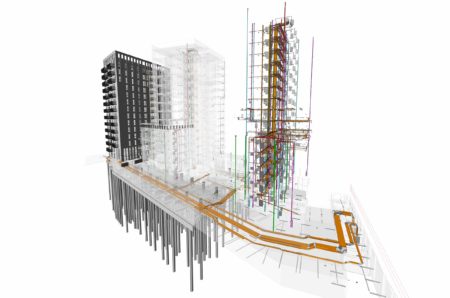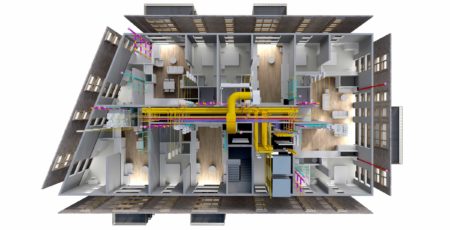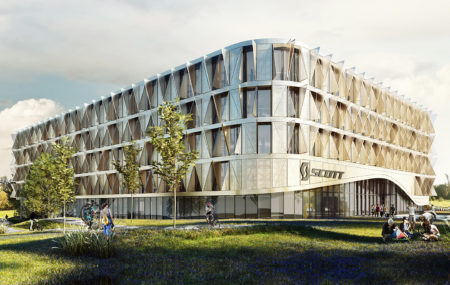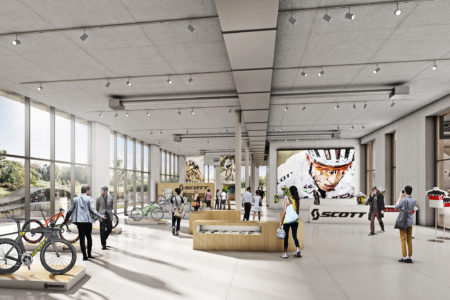SOME OF THE BIGGEST FIRMS in Europe are using Vectorworks Architect. The popular design and BIM software is known worldwide for its highly regarded graphics capabilities. In addition to that history, the BIM/CAD software has consistently been delivering top results for large firms worldwide on complex projects with BIM level 2 deliverables. Architosh decided to take a deep dive with two such firms in the UK and Europe to understand how they deliver Big BIM projects with Vectorworks.
Assael Architecture
Assael Architecture, a 100-plus person architecture practice in London with both integrated landscape, interiors, and visualization teams, is a longtime Vectorworks user. The practice tackles complex, mixed-use, and residential-led urban projects, often with demanding density challenges. “The directors were actually using the software when they started the firm,” said Simon Pitt, Director, Assael. “The firm has been using Vectorworks since the day it was called MiniCAD.” Pitt described the firm’s evolution from the pre-BIM days to their BIM transformation as very reasonable and fluid for much of their senior staff who, without knowing it, we’re already working with 3D BIM elements when the firm made the push to develop BIM level 2 competence. New hires and recent grads are sent out for three days of Vectorworks training, then immediately immersed in active projects. “One of the things I love about Vectorworks is it is just very user-friendly and intuitive to use,” adds Pitt.

London-based, Assael Architecture specializes in several building types, but residential urban infill development is chief among them. The firm has a staff of 100. (image: Assael Architecture / Architosh. All rights reserved.)
Assael began its transition to BIM in 2013 and slowly developed its BIM processes and workflows. “It took teams 2-3 years to fully make the transition,” says Pitt. “Some teams were a bit faster or slower than others, but it makes a real difference to have a BIM or Vectorworks champion inside of each team,” he adds. The firm itself only has one BIM manager in Ben Lam, an associate with the firm. Pitt, as a director, oversees technologies and research as part of his other leadership roles.
As their BIM competencies grew, the firm became well positioned for one of its signature projects: Pontoon Dock. The challenging urban residential-use project consists of 154 private rented apartments and 82 affordable homes. It also needed to navigate site complexities dealing with a viaduct outside Pontoon Dock DLR Station and the Thames Barrier Park. Moreover, to top it all off, it needed to be executed to the BIM level 2 standard.

Image of BIM model shows some of the urban infill complexity of the Pontoon Dock project. (image: Assael Architecture / Architosh. All rights reserved.)
Lam says a vital part of the success at Pontoon Dock was the BIM Execution Plan (BEP), which gained input from multiple sources, including UK government BIM guidelines. “As you know, in the UK, it was mandated that BIM level 2 be in effect by April 2016,” said Pitt, “but that was only for publicly funded projects from the government. However, we found a lot of private clients at that time would wish that their projects would be BIM level 2.”
One of the things I love about Vectorworks is it is just very user-friendly and intuitive to use.
The firm’s current BEP approach is modeled on a series of successful BIM projects. For Pontoon Dock an Open BIM workflow was baked into the BIM Execution Plan, with a standard set of exchanges happening on a particular time frame. “Our consultants were mostly using Revit, but our BIM Execution Plan promoted Open BIM,” said Lam, “and we would exchange software files as IFC. Assael did real trial runs on actual project files to flesh out the exchange process. “It took a bit of extra time and testing,” he added, “but that way we could make sure that everything was working the way we wanted it to.”

Pontoon Dock was implemented using BIM Level 2 standard using Vectorworks Architect. (image: Assael Architecture / Architosh. All rights reserved.)
During Pontoon Dock, they used Solibri for federating models from various offices and running clash detection, coordination, and model assurance. Assael also utilized BIMcollab for inter-team collaboration on the BIM models; Solibri’s image snapshots with markups were sent up to BIMcollab in the cloud as a CDE tool. “So if a mechanical engineer sees a clash somewhere, he will generally create a report in Solibri which consists of an image of the clash and a few notes,” adds Pitt. “Then that gets loaded into BIMcollab, and from there it goes to certain parties who are responsible for wherever a clash happens. So it would be instantaneous when that happens.”
Itten+Brechbühl AG
Itten+Brechbühl is one of the largest architecture firms in Europe, with over 320 staff, based in Switzerland. It also arguably belongs to the offices with the most in-depth competencies in BIM inside of Switzerland. Also, like Assael, the Swiss firm has been using Vectorworks for a very long time.
The firm has expertise across a wide variety of build types, many of them technical like healthcare architecture. A giant within a small country, Itten+Brechbühl has well-established Big BIM competencies based on a high involvement in BIM standards within the region and applying these standards to their projects—with Vectorworks.

Scott Headquarters is a sophisticated recently completed BIM project that relied on Open BIM processes with the ISO 16739 standard. (image: Itten+Brechbühl / Architosh. All rights reserved.)
“For the Swiss speaking part of our offices the main CAD system is Vectorworks for creating plan products or IFC models,” said Marc Pancera, an associate and the firm’s head of BIM Research & Development. Pancera notes that a range of software tools are operational within the firm, and it varies concerning staff preferences and what languages are spoken in various offices. For early-stage design, Pancera says that people often use what they like on projects. “It could be people are using a bit of Rhino and Grasshopper or a bit of SketchUp or perhaps even Vectorworks as a drawing or sketching tool,” he adds. “But as soon as we need to produce BIM models and technical plans, Vectorworks is there for us.”
Like Assael, Itten+Brechbühl has committed to Open BIM processes and has developed deep competencies in Open BIM workflows. “Everything we do we try to do using open standards like IFC, BCF, or MVD…so actually what is called Open BIM. All our projects shall have a BIM-ready setup no matter if BIM is asked for or not. Except for small residential or renovation projects, which may be BIM-based, but require project-specific clarification of objectives and use cases. As early adopters of BIM, we have a little bit of an advantage, but it is one thing that you are ahead, but it also means you had to figure out all the new ways of working mostly by yourself,” said Pancera.

The Scott Headquarters building’s BIM model image shown here. The project consisted of a very complex facade system. (image: Itten+Brechbühl / Architosh. All rights reserved.)
Open BIM too may involve a continuous stream of new ways of working. The “open” part means teams use a wide variety of software tools and interoperate with each other using Open BIM technologies. While some architects may feel that using the same tool as their consultant will make the collaboration process easier, they will probably find that they need to adapt their processes for each project again and again and therefore compromise the quality of standard for their own delivery. Using the IFC data model as a baseline for information requirements benefits companies, clients, and authorities equally. Such firms like Itten+Brechbühl and Assael develop more agility committing to Open BIM because they face more ongoing variation in tools and workflow scenarios.
As early adopters of BIM, we have a little bit of an advantage, but it is one thing that you are ahead, but it also means you had to figure out all the new ways of working mostly by yourself.
Those architects who haven’t yet made the jump to BIM fear the drop in productivity as they move away from either an old tool or an old process—or both! However, they fail to see the process as an opportunity to build competencies in BIM or even new business models. Figuring out the process changes to move to BIM develops firm-based competencies that add ongoing value to AEC discipline businesses. “We try to be involved in national or regulatory BIM committees so we can contribute to standards and see where it will go with our firm,” said Pancera.
A recent project by Itten+Brechbühl demonstrates the broad BIM competencies of the firm. The Scotts Sports Headquarters project was fully realized in Vectorworks Architect and involved a complex facade system. Both the design and the production documents were implemented by the firm, with a complete Open BIM IFC-based BIM process for working with consultant engineers. Significant projects at the firm can consist of teams larger than 40 people or more, including all consultants. Unlike Assael Architecture, Pancera said that CDE platforms are yet not used as often as he would wish because the collaboration platforms in Switzerland do not cover the actual needs for model-based collaboration. BCF-management can very well be achieved by tools like BIMcollab, but there are many other issues of data management, reprographics services, field deficiency management, et cetera, which currently have to be handled with different platforms. Pancera notes this is less optimal and says, “for a real and open collaboration environment we can learn a lot from Scandinavia, in this case to Dalux or Bimsync.

An interior view of the Scott Headquarters building project. (image: Itten+Brechbühl / Architosh. All rights reserved.)
Vectorworks Architect is fully capable of managing large-scale BIM projects through its multi-user environment, Project Sharing, wherein a master or Project File is created from which Working Files can be pulled to edit and add information and then get synchronized back to the project file. Itten+Brechbühl also still uses referencing technology and has maintained and continually developed a firm-wide file naming convention that tightly organizes project files so that data is well managed. For their firm, Marionette technology is yet less used for sophisticated geometry generation but more used for data. “We have done a little plugin,” adds Pancera, “which reads the space program from an Excel spreadsheet and directly creates spaces with the correct size in Vectorworks, including all necessary data fields such as planned area, occupancy, name, etc., from the spreadsheet. That may be a little nerdy, but I like that kind of stuff.”
Visualization and Looking Towards the Future
Pancera said that while Renderworks is essential as a component of the firm’s tools, Itten+Brechbühl farms out rendering needs during competitions. “We do those externally because we are generally not fast enough as people who do that kind of work full time,” he says. For internal work, the firm explores VR using IrisVR’s Prospect or The Wild. “We use a variety of visualization types,” he adds, “like data visualizations or gypsum (white) renderings using Vectorworks’ Renderworks technology.”
Assael Architecture, on the other hand, has built up its own visualization department. Simon Pitt says the team uses Autodesk 3ds max mostly. “Basically, the work they do comes from Vectorworks [BIM] models,” he notes. Vectorworks can export directly into that 3ds file format. “Vectorworks Renderworks is still very important to us,” adds Pitt. “Elevation views are flat-on Renderworks views of the model, with textures and shadows.”
We use a variety of visualization types, like data visualizations or gypsum (white) renderings using Vectorworks’ Renderworks technology.
Pancera was pleased to see the new Lumion addition to Vectorworks 2019. “We are also hoping for Enscape or Twinmotion,” he added. “Those are the three tools that are very impressive and easy to handle. With those tools, we can do the work ourselves and give them to the client as an experience of being in the model,” he said. Pancera sees that while IrisVR is an excellent tool for “intra-team” design evolution work, what they really want is to take IFC models directly into Virtual Reality for collaboration.
It is clear from talking to BIM leaders like Assael and Itten+Brechbühl that their competencies in BIM are at the edge where they are pushing on and extending BIM deeper into other processes and phases of the work; this is now common among all the BIM authoring platform leaders, of which Vectorworks is one. The desire to extend BIM and BIM models to discreet tools and workflows is a precise index of a mature BIM leader. Simon Pitt says that an area where his clients have asked them to go is towards FM (facilities management). “Because we do a lot of build-for-rent projects, our clients are very interested in CAFM (computer-aided facilities management) software programs.”
Closing Thoughts
While Vectorworks may consistently be associated with design-led firms, including “starchitects” who are famous for remarkable drawings and visuals, the US-based BIM leader offers large and enterprise architecture firms a robust and capable platform for BIG BIM that defies the common assumptions.
Marc Pancera summed up the irony well. “Some people may think of Vectorworks Architect as this Adobe Illustrator-like CAD tool, but whenever we need to look at something in architecture, we have a two-dimensional view of a three-dimensional element. It could be axonometric, perspectival or more sophisticated—in the end, you need to explain something, you need to take out the complexity of the whole, so you can focus on a scheme, a concept, an element—the architect’s goal is always to reduce complexity and focus on what is important.” Pancera says having those graphics legacies and somewhat legendary tools married to modern BIM features helps Itten+Brechbühl do precisely that.




Reader Comments
Comments for this story are closed